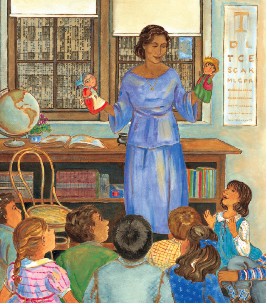 Jill Eisenberg, our Resident Literacy Expert, began her career teaching English as a Foreign Language to second through sixth graders in Yilan, Taiwan as a Fulbright Fellow. She went on to become a literacy teacher for third grade in San Jose, CA as a Teach for America corps member. She is certified in Project Glad instruction to promote English language acquisition and academic achievement. In her column she offers teaching and literacy tips for educators.
Jill Eisenberg, our Resident Literacy Expert, began her career teaching English as a Foreign Language to second through sixth graders in Yilan, Taiwan as a Fulbright Fellow. She went on to become a literacy teacher for third grade in San Jose, CA as a Teach for America corps member. She is certified in Project Glad instruction to promote English language acquisition and academic achievement. In her column she offers teaching and literacy tips for educators.
1. Teaching Students About Narrator Bias
Etched In Clay is a compelling case study for narrator bias and trustworthiness. The text structure with 13 narrators and its economy of words make Dave’s story captivating, especially to middle grade  students who are beginning to engage with primary sources from the period of American slavery. Students can analyze how each speaker’s social experiences, status, motivations, and values influence his/her point of view, such as evaluating the poems of the slave-owners who would have had a vested interest in popularizing a particular narrative of slavery.
students who are beginning to engage with primary sources from the period of American slavery. Students can analyze how each speaker’s social experiences, status, motivations, and values influence his/her point of view, such as evaluating the poems of the slave-owners who would have had a vested interest in popularizing a particular narrative of slavery.
Using multiple perspectives to tell the story of one life is a striking display of how events can be interpreted and portrayed by different positions in the community. Students face the task of examining the meaning and nuance of each narrator (13 in total!) and what they choose to convey (or don’t).
Discussion questions include:
- Why might the author choose to share Dave’s story using multiple speakers? How do multiple narrations develop or affirm the central idea?
- How do the author’s choices of telling a historical story in present tense and first person narration affect our sympathy toward the narrators and events in the book?
- Select a poem, such as “Nat Turner,” and defend why the author chose a particular narrator to tell that event or moment. How would the event and poem be different if another, like Reuben Drake, had told it?
- Are there narrators the readers can trust more than others? Why or why not? What makes a narrator (un)trustworthy? How is each narrator (un)reliable? Why might one of these narrators not tell readers the “whole” truth? Does having more than one narrator make the story overall more reliable? Why or why not?
- How does a narrator’s position in society or in Dave’s life affect what he/she knows? How does the historical context affect what a narrator may or may not know and his/her reliability? How can readers check a narrator’s knowledge of facts?
- What is the motivation of each narrator to share?
- Does this alternation between narrators build compassion or detachment for Dave in readers? How so?
- Why is it important to learn the history of slavery from slaves themselves?
- Compare and contrast the conditions of slavery from Dave’s point of view and Lewis Miles.
- How do the slaveholders depict the relationships with their slaves? How do the slaves depict their relationships with the slaveholders?
- Compare Dave and Lewis Miles’ perceptions of the Civil War.
- Consider whether Dave and David Drake should be considered one perspective or two.
- Contrast how each narrator feels about antebellum South Carolina.
- Who might be the audience the narrators are telling their version of events to (themselves, God, a news reporter, etc.)? Are they the same? Why is intended audience important to consider?
- Argue whether 13 points of view flesh out this figure or make Dave and his life even more elusive.
2. Poetry Month and Primary Sources
As “Primary Sources + Found Poetry = Celebrate Poetry Month” suggests, the Library of Congress proposes an innovative way to combine poetry and nonfiction. Teaching With The Library of Congress recently re-posted the Found Poetry Primary Source Set that “supports students in honing their reading and historical comprehension skills by creating poetry based upon informational text and images.” Students will study primary source documents, pull words and phrases that show the central idea, and then use those pieces to create their own poems.
This project not only enables teachers to identify whether a student grasps a central idea of a text, but also encourages students to interact with primary sources in much the same way as Etched In Clay’s Andrea Cheng. When researching Dave’s life and drawing inspiration for her verses, Andrea Cheng integrated the small pieces of evidence of Dave’s life, including poems on his pots and the bills of sale.
3. Common Core and the Appendix B Document
Many middle school educators are currently using Henrietta Buckmaster’s “Underground Railroad,” a recommended text exemplar for grades 4-5, and Ann Petry’s Harriet Tubman: Conductor on the Underground Railroad and Frederick Douglass’s Narrative of the Life of Frederick Douglass An American Slave, Written by Himself, recommended text exemplars for grades 6-8 in the Common Core State Standards’ Appendix B document.
Educators can couple Etched In Clay with those texts to involve reluctant or struggling readers, prepare incoming middle school students, and scaffold content and language for English Language Learners. Additionally, Andrea Cheng’s biography offers educators an inquiry-based project for ready and advanced readers to analyze “how two texts address similar themes or topics in order to build knowledge or to compare the approaches the authors take” (CCSS.ELA-LITERACY.CCRA.R.9).
For a more inclusive, diversity-themed collection of contemporary authors and characters of color, check out our Appendix B Diversity Supplement.
Further reading:
Andrea Cheng on Writing Biography in Verse
Filed under: Curriculum Corner Tagged: African/African American Interest, appendix b, CCSS, close reading, common core standards, Educators, ELA common core standards, History, National Poetry Month, poetry, reading comprehension, slavery







Great post! I really appreciate the additions you suggested to Appendix B. I think the two points you make about what to consider when creating a classroom library are essential! So glad that I found your blog–you’ve got some invaluable resources here!
[...] for links to literacy standards such as the Common Core State Standards Reading Literature Standard 6 across grade levels; this is [...]
[...] creation of the Common Core Standards (!!!!!), and she gave me some important feedback about the Appendix B supplement I posted last week. To refresh your memory, what we’ve done is compiled a supplement to [...]